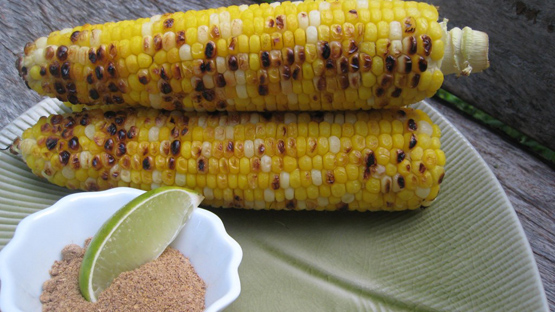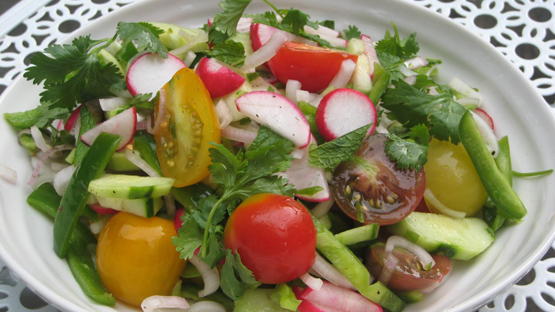This is the first blog from our trip around the south of India where we hope to find some of the rapidly disappearing foods of the area. As a result of the huge social, environmental and economic changes taking place across India, many of these traditional recipes, ingredients and methods of preparing food are vanishing. This blog will document our travels in the south of India.
WORDS by Cameron Stauch, IMAGES by Jason Taylor
We made our way from Mumbai to Goa and stayed with some good friends of Jason. Aggi shared with use two different versions of the Goan style chorizo sausage which had some nice heat and texture to them. He also shared with us a simple green coriander coconut chutney and some local bread to spread it on. It tasted absolutely fresh and was addictive!
Driving along the highway, just before you cross the border into Karnataka we stopped along the side of the road for some chai and breakfast. Our driver, Sanjay, said they made a good potato samosa. The potato filling was delicately spiced, yet well balanced, with turmeric, onions, green chillies, mustard seeds and fresh coriander. Unlike in the north where a flour dough is wrapped around the potato filling, this filling was made into balls and then dipped into a chickpea flour batter and deep fried. Once we all tasted Suresh’s fantastic Potato Dumplings we each devoured a few more. This simple meal had been the best we had eaten in days.
We arrived in the north coastal port town of Karwar. I had read about the good Konkani dishes served at Amrut Hotel so we ventured in to meet the owner, S.R. Neelavar. Fortunately for us his grandson, Bhaarath, was in charge that day and we explained to him what we were doing in Karwar. As he made some phone calls his kitchen sent out a lovely clam sukhe (clams lightly dressed in a red chilli coconut sauce). The clams were tender and every once in a while a small sweet chunk of coconut would counterbalance the heat from the red chillies.
Bhaarath introduced us to Satish, manager of Riveredge Retreat about 19 kilometres outside Karwar. Little did we know how knowledgeable, hospitable and helpful Satish could be. He led us to daily fish market where we saw the wives of local fishermen selling clams, mackerel, crabs, oysters, shrimp, shad and tiny white fish. The seafood seemed too good to pass up so we bought some for dinner along with some local amaranth greens and fresh coconut. That night we had some lovely seafood and a great dish of sautéed amaranth greens with grated coconut and tiny shrimps.
Satish had arranged for us the next day to visit the home of a highly regarded cook in the village of Hankon. As we arrived Rukmani was just finishing her morning pooja. Rukmani guided us through several traditional dishes. It was amazing to see her work the stone masala grinder. She would move the large stone rhythmically counter clockwise while at the same time using her right hand to push any masala which came out of the grinding hole back into it. Although using the stone grinder takes longer than a modern mixer she feels that the flavour of a dish is far superior. She felt similarly about the fuel she cooked with. Rukmani used the gas burners in her modern kitchen only for making tea or if she was late getting the food together. She much preferred cooking over coals at the back of the house, as again, she felt the masala cooked more gently and resulted in a much tastier dish. Rukmani made us a light morning snack of rice gruel with a dried clam, chilli and coconut chutney. We followed this with some tea and a great coconut peanut laddoo delicately flavoured with fresh cardamom made by the mother of Nisha, her daughter in law.
Rukmani in her kitchen serving up one of the two fish curries.
Using virtually the same masala ingredients but in different quantities, Rukmani made two fish curries: one with mackerel and the other with a river fish. The mackerel was unique in that the sauce had a lovely citrus aroma to it due to a local dried berry, pepper-anise. The river fish curry on the other hand tasted much sweeter due to the flavour of the fish and the use of more grated coconut. Lunch was finished with a unique mung dal coconut jaggery dessert. Rukmani and her family were extremely hospitable and she was happy to share some of her culinary secrets with us. We felt very honoured to have been welcomed into their home.
Two plates with the ingredients for the mackerel and the sweet water fish curries.

After preparing the Mackerel, Rukmani washes the fish with sweet water from her garden well.

The following day we met Sailash who invited us to go and collect clams in the brackish water (a mixture of salty sea water and sweet river water) outside his village. Sailash, along with two of his fishing friends, taught us how to use our feet to find the river clams two to three inches below the sandy bottom. We met several village women also collecting clams in the low, thigh high, tide. Sailash then took us to the mangroves along the shore to collect the much larger black clams. Shailesh spends much of his time wading through the shallow waters of the estuary using his feet to find clams buried in the sands.
Shailesh spends much of his time wading through the shallow waters of the estuary using his feet to find clams buried in the sands.
By using the heels of their feet and walking backwards, local fishermen are able to lift the clams from the warm shallow waters of the rivers estuary.
Taking the clams back home for lunch.
We then returned back to his home for lunch where his wife, Seejal, made a spicy clam and crab curry with our fresh catch. Her version of mackerel rava fry (fish coated with a semolina crust) was particularly tasty.
Clam and crab being cooked by Sejal, Shailesh’s wife, before adding a coriander, onion and chilly curry.

Mackerel fry.
As we have travelled along the north coastal region of Karnataka, we met and talked with many people. Many agree that traditions must be shared – and that biodiversity begins in the kitchen.
and some more images.

Mackerel being sold in Karwar fish market. These locally caught fish are part of the west coasts staple diet and are either used dry fried or in a curry.

Rukmani preparing the ingredients to the fish curries.

Working with the large balanced grinding stone takes little effort.

The clam chutney made by Rukmani.

Rukmani’s husband Vitthal and their grand daughter eating her clam chutney and local rice as part of their lunch.

Night time in a small village just outside of Karwar, Kanataka.

One of the local clam fishermen leaving the shallow waters after a morning’s work.

Cameron gets a ride out to the estuary shallows with two of the local fishermen to see how they find the clams.

One of the local women collecting clams.

After a morning of collecting, Shailesh begins to open and clean these clams.

NOTE: This was originally posted on my blog India On My Plate on January 15, 2011
Fresh limes in Karwar market.










 Shailesh spends much of his time wading through the shallow waters of the estuary using his feet to find clams buried in the sands.
Shailesh spends much of his time wading through the shallow waters of the estuary using his feet to find clams buried in the sands.













